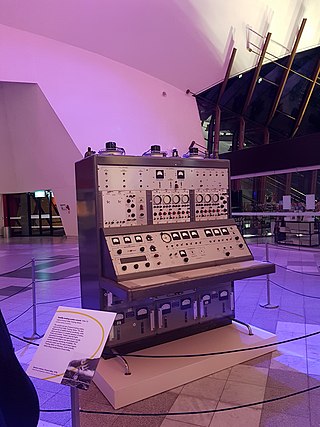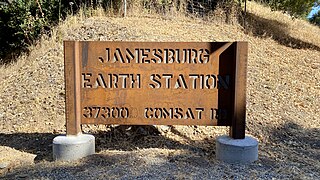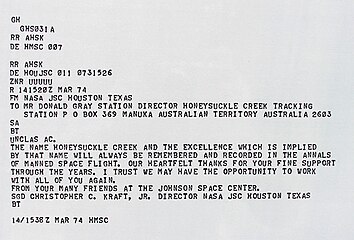
The Apollo Lunar Module, originally designated the Lunar Excursion Module (LEM), was the lunar lander spacecraft that was flown between lunar orbit and the Moon's surface during the United States' Apollo program. It was the first crewed spacecraft to operate exclusively in the airless vacuum of space, and remains the only crewed vehicle to land anywhere beyond Earth.

The NASA Deep Space Network (DSN) is a worldwide network of spacecraft communication ground segment facilities, located in the United States (California), Spain (Madrid), and Australia (Canberra), that supports NASA's interplanetary spacecraft missions. It also performs radio and radar astronomy observations for the exploration of the Solar System and the universe, and supports selected Earth-orbiting missions. DSN is part of the NASA Jet Propulsion Laboratory (JPL).

Russell Louis "Rusty" Schweickart is an American aeronautical engineer, and a former NASA astronaut, research scientist, U.S. Air Force fighter pilot, as well as a former business executive and government executive.

The Dish is a 2000 Australian historical comedy-drama film that tells the story of the Parkes Observatory's role in relaying live television of humanity's first steps on the Moon during the Apollo 11 mission in 1969. It was the top-grossing Australian film in 2000.

The Goldstone Deep Space Communications Complex (GDSCC), commonly called the Goldstone Observatory, is a satellite ground station located in Fort Irwin in the U.S. state of California. Operated by NASA's Jet Propulsion Laboratory (JPL), its main purpose is to track and communicate with interplanetary space missions. It is named after Goldstone, California, a nearby gold-mining ghost town.

Edward George Gibson is a former NASA astronaut, pilot, engineer, and physicist.

Parkes Observatory is a radio astronomy observatory, located 20 kilometres (12 mi) north of the town of Parkes, New South Wales, Australia. It hosts Murriyang, the 64 m CSIRO Parkes Radio Telescope also known as "The Dish", along with two smaller radio telescopes. The 64 m dish was one of several radio antennae used to receive live television images of the Apollo 11 Moon landing. Its scientific contributions over the decades led the ABC to describe it as "the most successful scientific instrument ever built in Australia" after 50 years of operation.

The Canberra Deep Space Communication Complex (CDSCC) is a satellite communication station, part of the Deep Space Network of NASA's Jet Propulsion Laboratory (JPL), located at Tidbinbilla in the Australian Capital Territory. Opened in 1965, the complex was used for tracking the Apollo Lunar Module, and along with its two sister stations at Goldstone, California and Madrid, Spain is now used for tracking and communicating with NASA's spacecraft, particularly interplanetary missions. Its DSS-43 antenna is the only antenna on Earth that can send commands to Voyager 2. It is managed in Australia by the Commonwealth Scientific and Industrial Research Organisation (CSIRO) for NASA’s Space Communications and Navigation program (SCaN) at NASA Headquarters in Washington, D.C.

Maspalomas Station is an INTA-operated, ESTRACK radio antenna ground station for communication with spacecraft located at the southern area of Gran Canaria island, on the INTA campus. It is situated on the Montaña Blanca hill and is visible from the coastal resort of Meloneras, close to Maspalomas. It was originally established in the 1960s to support NASA's nascent human spaceflight program.

The Orroral Valley tracking station was an Earth station in Australia, supported Earth-orbiting satellites, as part of NASA's Spacecraft Tracking and Data Acquisition Network (STADAN). It was located approximately 50 km south of Canberra, Australian Capital Territory (ACT), and was one of three tracking stations in the ACT, and seven in Australia.

The Island Lagoon Tracking Station, an Earth station in Australia, was the first deep space station to be established outside of the United States, near Woomera, South Australia in November 1960.

The Carnarvon Tracking Station was an Earth tracking station in Australia, located 10 kilometres south of Carnarvon, Western Australia. It operated from 1963 until 1975, during which it supported the Gemini, Apollo and Skylab space programs.

The Apollo 11 missing tapes were those that were recorded from Apollo 11's slow-scan television (SSTV) telecast in its raw format on telemetry data tape at the time of the first Moon landing in 1969 and subsequently lost.

Third-party evidence for Apollo Moon landings is evidence, or analysis of evidence, about the Moon landings that does not come from either NASA or the U.S. government, or the Apollo Moon landing hoax theorists. This evidence provides independent confirmation of NASA's account of the six Apollo program Moon missions flown between 1969 and 1972.

The Jamesburg Earth Station is located in the rural Cachagua area of Carmel Valley, California, about 26 miles (42 km) southeast of Monterey. It was originally built in 1968 to support the Apollo 11 Moon landing.

The OTC Satellite Earth Station Carnarvon, an Earth station in Australia, was established to meet the need for more reliable and higher quality communications for the Apollo program. NASA contracted Australia's Overseas Telecommunications Commission (OTC) "to provide an earth station near Carnarvon, Western Australia to link the NASA tracking station in that area to the control centre in the USA", also contracting COMSAT to launch three Intelsat-2 communications satellites.
The Manned Space Flight Network was a set of tracking stations built to support the American Mercury, Gemini, Apollo, and Skylab space programs.
There are NASA facilities across the United States and around the world. NASA Headquarters in Washington, DC provides overall guidance and political leadership to the agency. There are 10 NASA field centers, which provide leadership for and execution of NASA's work. All other facilities fall under the leadership of at least one of these field centers. Some facilities serve more than one application for historic or administrative reasons. NASA has used or supported various observatories and telescopes, and an example of this is the NASA Infrared Telescope Facility. In 2013 a NASA Office of the Inspector General's (OIG) Report recommended a Base Realignment and Closure Commission (BRAC) style organization to consolidate NASA's little used facilities. The OIG determined at least 33 of NASA's 155 facilities were underutilized.

The forerunner of the Deep Space Network was established in January 1958, when JPL, then under contract to the U.S. Army, deployed portable radio tracking stations in Nigeria, Singapore, and California to receive telemetry and plot the orbit of the Army-launched Explorer 1, the first successful U.S. satellite.
Thomas Reid MBE was the director of the Honeysuckle Creek Tracking Station outside Canberra, Australia, which in July 1969 transmitted live television of Neil Armstrong stepping onto the Moon to a world-wide audience of 600 million people.



















